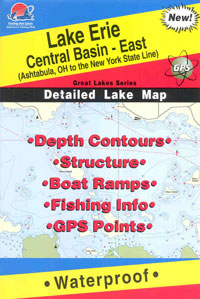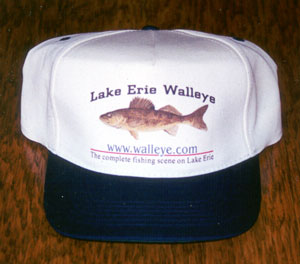|
High Seas Walleyes
by
Ted Takasaki and Scott Richardson
If you didn't know better, open-water trollers may look a little
like drunken sailors. What could they possibly be doing.... weaving this way and that with
planer boards out to the sides of their boats seemingly trolling
nowhere without any rhyme or reason?
What could they possibly be doing.... weaving this way and that with
planer boards out to the sides of their boats seemingly trolling
nowhere without any rhyme or reason?
Actually, nothing could be farther from the truth. A closer look
reveals that open-water trollers on the Great Lakes and large inland
lakes are traveling along subtle breaklines that walleyes follow
during their seasonal migrations. The trollers know walleyes relate
to certain areas of a body of water at certain times for reasons
that can be explained. The fish are not scattered at random.
Sometimes structure is defined by a mere drop of a foot or two
over a half mile. But, if you imagine yourself flying many miles
above while all the water is drained from the lake, you'd see that
those contours are really structure on a macro scale. And the
walleyes use them. It's all they have. They will be on the breaks or
suspended nearby.
Understanding the importance of those tiny details and using them
to your advantage can lead to a more and bigger fish. Take for
example, Ted's basket of five fish weighing 53.2 pounds on Lake Erie
during the 2002 Professional Walleye Trail tournament last spring.
The total stands as a PWT one-day record.
Let's look at Lake Erie. What you learn there can be applied
elsewhere.
Spring? Head west. Walleyes in Lake Erie congregate on the reefs
in the Western Basin or travel up feeder rivers to spawn in March
and April. Look for hard bottom structure and incoming water or wave
action that supplies oxygen to eggs.
Walleyes start to move east once spawning is done. They filter
through passages between the Bass Islands during April and May. Try
trolling in and around the islands until you determine the most
productive channel.
The importance of finding the tiny points and turns along the
breaklines becomes clear when years of GPS coordinates that produced
fish in the past are overlaid on a map of the lake. The spots were
fish are caught are often on the breaks or close by. Knowing where
they are and why will make finding walleyes predictable even in the
biggest waters.
Big water, big advantages.
As overwhelming as it may seem at first, open-water trolling on
large bodies of water has its advantages. Its biggest strength lies
in states where anglers may use more than one rod each. Fishermen
can spread several lines out to the sides of the boat with planer
boards. They can use a variety of lures or bottom bouncers and/or
snap weights with spinner rigs and live bait at different depths to
sift large areas of water from side-to-side and top-to-bottom
looking for active fish.
Jigging, meanwhile, covers only a tiny bit of water. Certainly,
there are times even on the Great Lakes or a vast inland lake or
reservoir that covers thousands of acres when a jig is right
approach. Those times are when walleyes are concentrated and
relating to bottom structure. Cold fronts are often good times to
jig.
But, open-water trolling is the method of choice when walleyes
are scattered over larger areas or flats. The odds of putting baits
in front of active biters are higher when you're moving through the
water from 1 mph to 3 mph.
Whether open-water trolling, jigging or rigging, structure is the
key to finding fish on any body of water. Locate key points, reefs,
underwater humps and troughs by studying maps of the area. Enter GPS
coordinates in your unit. Visit web sites devoted to the body of
water you are targeting. Walleyecentral.com is a good starting
point. Stop at local bait shops and ask questions designed to
determine exactly where walleyes are in their annual migration. What
depth have they been in the past few days? What methods have worked?
What lures, what colors, what boat speed? If spinners have been the
top tactic, what blade sizes and colors have produced the biggest
fish? Are they on the bottom? If not, what size snap weights are
being used with what combination of line out?
A general rule of thumb is - crankbaits work best under
50-degrees and spinner rigs work best over 50 degrees.
Whatever the method, the point is to sift the water column from
top to bottom and side to side. If fish appear tight to the bottom
early in the day, then seem to rise from the bottom as the morning
progresses, it's a safe bet they're suspended and could be up high.
Line-counter reels are critical for open-water trolling. Make
certain they have the same amount of line, same pound test, on all
of them. Everything must be identical to return baits to the same
location in the water column time and again. Eight-foot rods like
the St. Croix GT80M are perfect to troll boards in addition to
helping absorb the fight from trophy fish. A good sonar with
side-finding, like Bottomline's NCC6500, is a must for locating
suspended walleyes.
If running four rods, run two on bottom-bouncers and two on snap
weights. Choose large #4- to #6 Colorado or Hatchet blades when
targeting big walleyes like the Great Lakes offer. Use a majority of
metallic blades in sunlight and clear water or, a majority of
colorful blades on cloudy days and murky water. X-Change clevises
allow fast blade changes.
When crankbaits are the choice, refer to the book "Precision
Trolling" to figure out how much line to let out on each lure to
cover different depth zones. The dive curves in the book are based
on using 10-pound line. Use super-braided line to get smaller baits
down even deeper. Super lines are also better when trolling
shoreline breaks right behind the boat, where floating debris may
foul hooks. Check the lures often, especially when the rod tip stops
quivering from the wobble of the crankbait.
Try using a combination of a crankbait and live bait. Add a piece
of nightcrawler to the front treble hook or a whole one to the back
treble. Check the bait next to the boat to make sure the live bait
isn't spoiling the action of the lure.
Set one or two baits to run just above fish visible on the sonar
screen. Run one near the bottom and one high in the water column to
intercept walleyes cruising just under the surface.
Don't use the same baits on every line. Vary lure size, color and
action. Let the fish tell you what they want. Walleyes are like
people. Some prefer Arby's, some McDonald's, some the chicken at the
Colonel's. Give walleyes a choice. Every bite yields more
information to help zero in on the right combination to produce the
biggest and most fish on any given day.
Spread lines with planer boards. Start slow, about a half mile
per hour, with spinner rigs and increase your speed to 1.5 mph.
Start at 1 mph with lures and speed up to 3 mph. Make S-turns to
speed up outside lines and slow down inside lines. If walleyes show
a preference to outside or inside lines, speed up or slow down to
give them what they want. S-turns also swing baits out and away from
the structure to nab fish suspended just off the breaklines.
Don't troll helter-skelter. Use the tools to focus on the
structure, no matter how subtle, which hold fish. Success awaits you
on the high seas! |




 What could they possibly be doing.... weaving this way and that with
planer boards out to the sides of their boats seemingly trolling
nowhere without any rhyme or reason?
What could they possibly be doing.... weaving this way and that with
planer boards out to the sides of their boats seemingly trolling
nowhere without any rhyme or reason?